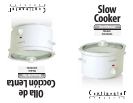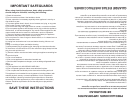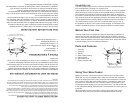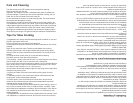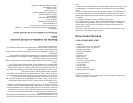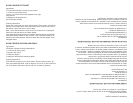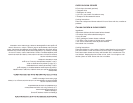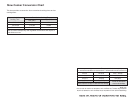Care and Cleaning
Turn the control to the OFF position and unplug before cleaning.
Remove the cord from the unit.
Important: The ceramic bowl will not withstand the shock of sudden tem-
perature changes. To wash your slow cooker right after cooking, use hot
water. Do not use cold water if the bowl is still hot.
Do not use abrasive cleaners or metal scouring pads. This could scratch
the surface and damage the coating.
After emptying, ll the bowl with sudsy water to loosen food particles. Do
not immerse the slow cooker. Use a cloth, nylon-covered mesh sponge or
rubber spatula to gently scrape away any residue. Rinse and dry thorough-
ly. Wipe the outside of the slow cooker with a clean, damp cloth and dry
thoroughly. A nonabrasive liquid cleaner may be used for stubborn stains.
Rinse and dry thoroughly. The glass lid may be washed in the dishwasher.
Tips For Slow Cooking
1) Vegetables cook slowly and should be kept small to medium in size and
placed in the bottom of the bowl.
2) Do not ll the bowl more than three-quarters full.
3) Meat should be trimmed, browned or broiled to eliminate as much fat as
possible.
Note: Do not use frozen meat. Thaw any meat before slow cooking.
4) Brown ground meat, such as ground beef and ground turkey, before
placing in bowl to remove excess fat and reduce the risk of food-borne ill-
nesses.
5) Unplug the slow cooker when not in use and before cleaning.
6) Always use oven mitts when lifting the bowl.
7) No peeking – always cook with the cover on. Removing the cover allows
heat to escape and add 15 to 20 minutes to the cooking time.
8) Your slow cooker has two temperature settings. Low is recommended for
slow, all-day cooking. High is recommended for cooking from 2 to 4 hours.
One hour on high is equal to 2 to 2 ½ hours on low.
9) Use fresh or dried herbs instead of ground; they keep more of their avor
during the long cooking time.
10) Spray the inside of the bowl with nonstick cooking spray for easy
cleanup.
11) Add dairy products, such as milk and cheese, toward the end of the
cooking time, unless recipe states otherwise.
12) Whole poultry, such as chicken and Cornish hens, should not be
cooked in slow cookers because safe cooking temperatures cannot be
reached quickly enough near the bone.
13) To thicken the avorful juices developed during slow cooking, remove 1
cup of juice from slow cooker. Place in small saucepan. Combine 1 table-
spoon water and 1tablespoon cornstarch. Stir into saucepan. Cook and stir
over medium heat until mixture boils. Boil and stir 1 to 2 minutes or until
slightly thickened.
14) Vegetables can be peeled and cut the night before slow cooking. Cover
and refrigerate in a separate container. Do not place in bowl until ready to
Cuidado y limpieza
Girar el control a la posición OFF (apagado) y desenchufar antes de limpiar.
Retirar el cable del electrodoméstico.
Importante: la cazuela de cerámica no resistirá el impacto de cambios brus-
cos de temperatura. Para lavar la olla de cocimiento lento inmediatamente
después de usarla, emplear agua caliente. No usar agua fría si la cazuela
está todavía caliente.
No utilizar limpiadores abrasivos ni esponjas de metal. Podrían rayar la
supercie y dañar el revestimiento.
Después de vaciar el contenido de la cazuela, llenarla con agua espumosa
para remover las partículas de alimento. No sumergir la olla de cocimiento
lento. Utilizar un paño, esponja revestida con tela de nylon o espátula de
goma para eliminar los restos de alimentos. Enjuagar y secar cuidadosa-
mente.
Limpiar el exterior de la olla con un paño limpio y húmedo y secar cui-
dadosamente. Se pueden utilizar productos limpiadores no abrasivos para
quitar manchas rebeldes. Enjuagar y secar cuidadosamente.
La tapa de vidrio se puede lavar en el lavavajilas.
Recomendaciones para la cocción lenta
1) Las verduras cocinan lentamente y deben utilizarse porciones pequeñas
o medianas y ubicarse en la parte inferior de la olla.
2) No llenar la olla por encima de las tres cuartas partes de su capacidad.
3) Las carnes se deben recortar, dorar o asar para eliminar la mayor canti-
dad posible de grasa.
NOTA: NO UTILIZAR CARNES CONGELADAS. DESCONGELAR TODAS
LAS CARNES ANTES DE LA COCCIÓN LENTA.
4) Dorar la carne picada, de vaca o pavo, antes de introducirla en la olla de
cocimiento lento para desgrasarla y reducir los riesgos de enfermedades
transmitidas por los alimentos.
5) Desenchufar la olla de cocimiento lento cuando no esté en uso y antes
de limpiarla.
6) Siempre utilizar mitones para horno para levantar la olla de cocimiento
lento.
7) No espiar – cocinar siempre con la tapa puesta. Levantar la tapa provoca
fuga de calor y aumenta en 15 a 20 minutos el tiempo necesario para la
cocción.
8) La olla de cocimiento lento tiene dos posiciones de temperatura. La
temperatura Low (baja) se recomienda para la cocción lenta que se ex-
tiende durante todo el día. La temperatura High (alta) se recomienda para
la cocción de 2 a 4 horas. Una hora de cocción en High es igual a 2-2½ de
cocción en Low.
9) Utilizar hierbas frescas o disecadas en lugar de molidas; mantienen más
el sabor a lo largo del prolongado proceso de cocción.
10) Rociar el interior de la olla de cocimiento lento con sustancia antiadher-
ente para facilitar la limpieza.
11) Incorpore los productos lácteos, como la leche y el queso, hacia el nal
del proceso de cocción, a menos que la receta indique otra cosa.



